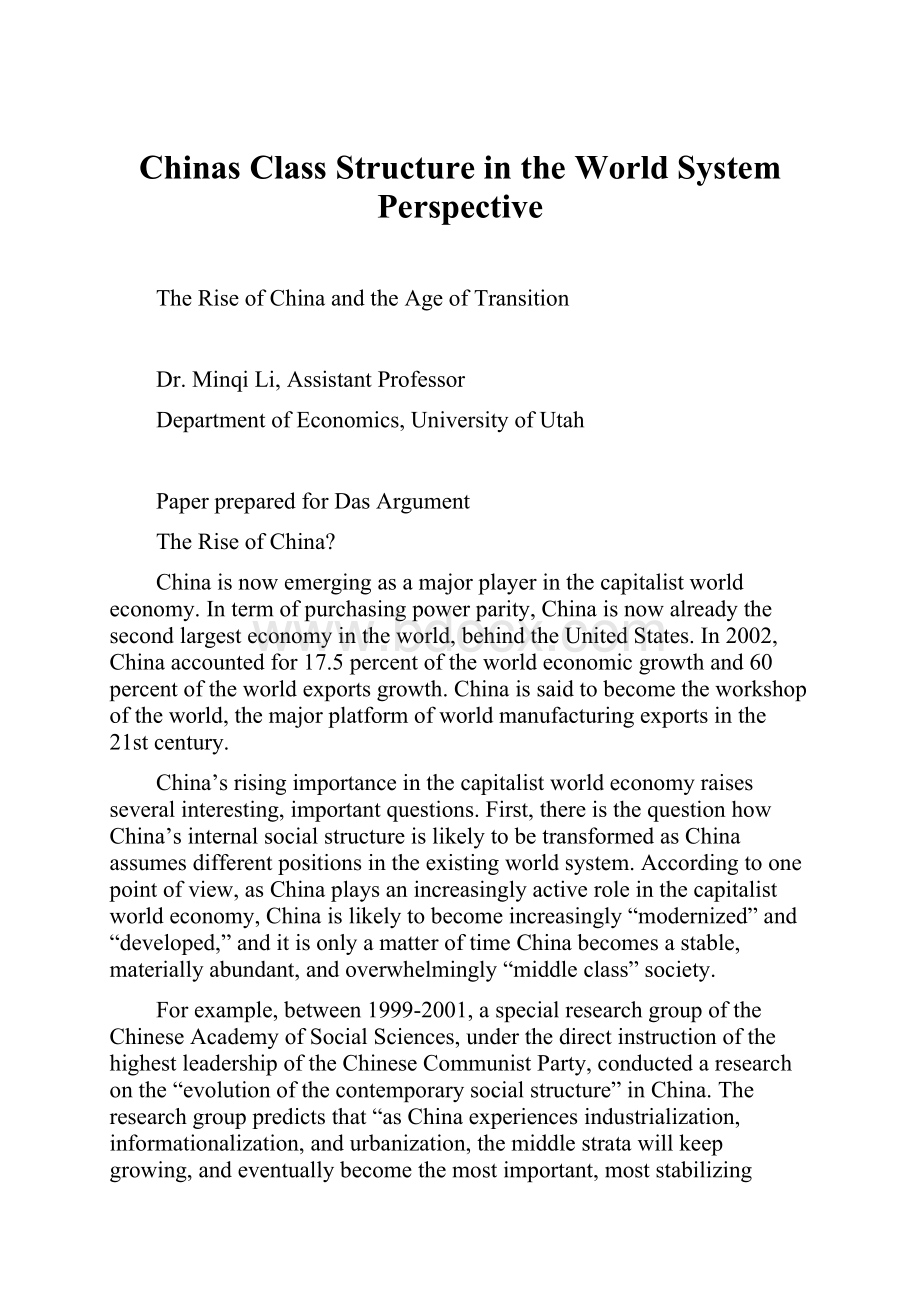Chinas Class Structure in the World System Perspective.docx
《Chinas Class Structure in the World System Perspective.docx》由会员分享,可在线阅读,更多相关《Chinas Class Structure in the World System Perspective.docx(15页珍藏版)》请在冰豆网上搜索。

ChinasClassStructureintheWorldSystemPerspective
TheRiseofChinaandtheAgeofTransition
Dr.MinqiLi,AssistantProfessor
DepartmentofEconomics,UniversityofUtah
PaperpreparedforDasArgument
TheRiseofChina?
Chinaisnowemergingasamajorplayerinthecapitalistworldeconomy.Intermofpurchasingpowerparity,Chinaisnowalreadythesecondlargesteconomyintheworld,behindtheUnitedStates.In2002,Chinaaccountedfor17.5percentoftheworldeconomicgrowthand60percentoftheworldexportsgrowth.Chinaissaidtobecometheworkshopoftheworld,themajorplatformofworldmanufacturingexportsinthe21stcentury.
China’srisingimportanceinthecapitalistworldeconomyraisesseveralinteresting,importantquestions.First,thereisthequestionhowChina’sinternalsocialstructureislikelytobetransformedasChinaassumesdifferentpositionsintheexistingworldsystem.Accordingtoonepointofview,asChinaplaysanincreasinglyactiveroleinthecapitalistworldeconomy,Chinaislikelytobecomeincreasingly“modernized”and“developed,”anditisonlyamatteroftimeChinabecomesastable,materiallyabundant,andoverwhelmingly“middleclass”society.
Forexample,between1999-2001,aspecialresearchgroupoftheChineseAcademyofSocialSciences,underthedirectinstructionofthehighestleadershipoftheChineseCommunistParty,conductedaresearchonthe“evolutionofthecontemporarysocialstructure”inChina.Theresearchgrouppredictsthat“asChinaexperiencesindustrialization,informationalization,andurbanization,themiddlestratawillkeepgrowing,andeventuallybecomethemostimportant,moststabilizingsocialforceswithinthemodernizedChinesestructureofsocialstrata.”(CASS2001and2002)
Secondly,thereisthequestionifChinais“rising,”thatis,ifitismovingupwardswithinthehierarchyoftheexistingworldsystem,howwillotherperipheralorsemi-peripheralcountriesbeaffected?
Onthisquestion,thesizeofChinaisofparticularimportance.Thecapitalistworldsystemisanunequal,hierarchicalsysteminwhichwealthandpowerhavealwaysbeenconcentratedonthetop.Giventhestructureoftheexistingworldsystem,theriseofChina,givenChina’senormoussize,cannotbuthavetohaveseriousimplicationsforotherperipheralandsemi-peripheralcountries?
Thirdly,thereisthequestionwhetherChinawillbecomethenexthegemonicpower.Ifthe20thcenturywassaidtobethe“AmericanCentury,”willthe21stcenturyturnouttobethe“CenturyofChina”?
InChaosandGovernanceintheModernWorldSystem(1999),GiovanniArrighiplacesmuchhopeontherenaissanceoftheChinesecivilization.ArrighihopesthatthereemergingChina-centeredcivilizationwouldprovidesystem-levelsolutionstothesystem-levelproblemsleftbehindbytheU.S.hegemonyandleadthetransformationofthemodernworldintoacommonwealthofcivilizations.
Fourthly,thereisthemorefundamentalquestion.Howwilltheunderlyingdynamicsoftheexistingworldsystemitself–thecapitalistworldeconomy–beaffected?
ImmanuelWallersteinhasarguedthattheexistingworldsystemhasenteredintoastructuralcrisis.Asthesystemdeveloped,severalseculartrendsemergedandhavenowreachedasymptotes,exhaustingthesystem’sabilityofself-adjustment.Wearenowinanageoftransition,attheendofwhichtheexistingsystemshouldbereplacedbyoneorseveralothersystems.Whataretheimplicationsofthe“riseofChina”intheageoftransition?
Howdoesthe“riseofChina”playapartinthetransition,andinthestructuralcrisis?
ChinaintheCapitalistWorldSystem
WhereisChinaplacedinthecapitalistworldeconomy?
China’spositionisreflectedbyitspositionintheglobalcommoditychainsaswellasitsclassstructure.
Letusconsideroneexampleofglobalcommoditychain.Table1reportstheglobaldistributionofvalueaddedineachstageofproductionanddistributionofamodelofglobeforchildren’sstudymadeinChinatobesoldintheU.S.markets.Inthisexample,China,aperipheralstate,receives10.5percentofthetotalvalueadded.HongKong,ageographicareathatarguablyhasasemi-peripheralpositionintheworldsystem,receives26.3percentofthetotalvalueadded.TheU.S.,thehegemoniccorestateintheworldsystem,receives63.2percentofthetotalvalueadded.Similarly,AndyXie,theMorganStanleychiefeconomistonAsia,estimatesthatforeachU.S.dollarinvalueforaproductthatChinaexportstotheU.S.,businessesinHongKongorTaiwantake20cents,andU.S.brandownersanddistributorsreceivethebulkofthebenefitsastheproductsellsfor4-5U.S.dollarsattheretaillevelintheU.S.(Xie2003).
Thevaluedistributionintheseexamplesisconsistentwithwhatisgenerallyobservedinglobalcommoditychains.Generally,thecorestatesreceivethelion’sshare,andtheperipheralandthesemi-peripheralstatesreceivethesmallersharesofthemarketvaluegeneratedintheglobalcommoditychains.
Intermoftheclassstructure,Chinahasarelativelylowlevelofproletarianization.TheChineseworkingclassesarepoliticalandeconomicallylesseffectivelyorganized,withrelativelylowerbargainingpower.Table2comparestheclassstructureforstateswithdifferentpositionsinthecapitalistworldsystem.
Inadditiontothewell-understoodbourgeoisieandpettybourgeoisie,theotherclassesaredefinedasfollows:
The“MiddleClass”:
Highlyskilled“professionals,technicians,andmanagers”have,toacertaindegree,monopolisticcontroloverthesupplyoftheirlaborpowerandtheirlaborisgenerallydifficulttomonitor.Theyperformeconomicandsocialfunctionsthatareofstrategicimportancetothecapitalistsystem.Tosecuretheirloyalty,thecapitalistshavetopaytheseworkersa“loyaltyrent,”sothattheirincomesaresignificantlyhigherthanthoseofotherworkers.Totheextenttheseworkerslivearelativelyprivilegedmateriallife,theyconstitutethe“middleclass”betweenthecapitalistclassandotherworkingclasses.
Proletariat:
Thefullyproletarianizedwageworkersaretheskilledandsemi-skilledworkersintheurbansector,whousuallyhavefull-timejobsinthe“formalsector.”Theirmoneyincomesentirelyoralmostentirelyderivefromwagelabor.
TheSemi-Proletariat:
Theunskilledwageworkersintheurbansector,whousuallyhavepart-timeorinsecurejobsandarefrequentlyunemployed,belongtothesemi-proletariat.Theirwageincomesarenotsufficienttomeettheiressentialneedsandtheyhavetoengageinpettymarkettransactionsorpettycommodityproduction,orworkinthe“informalsector”tosupplementtheirmoneyincomes.Intheperipheryandthesemi-periphery,manysemi-proletarianworkersare“migrantworkers”whospendpartoftheirlifetimeintheurbanareaandtherestoftheirlifetimeintheruralarea.Asubstantialpartoftheirrealincomescomefromruralfamilyproduction.
ThePeasants:
Theagriculturalpettycommodityproducerslivinginruralareasareknownasthe“peasants.”Intheperipheryandthesemi-periphery,peasantsandsemi-proletarianwageworkersoftenbelongtothesamehouseholds.Manysemi-proletarianworkersliveaspeasantsduringpartoftheirlifetime,andviceversa.Inthecontextoftheperipheryandthesemi-periphery,thepeasantsmaybeseenas“semi-proletarians”totheextenttheyfunctionastheruralreservearmyfortheurbanunskilledwageworkers.
WhatislikelytohappenasChinabecomestheworld’sworkshop?
Wearelikelytoobservethelargestproletarianizationtheworldhaseverseen.China’sclassstructurewillbefundamentallytransformed.Theshareoftheproletarianandsemi-proletarianwageworkersinthetotalpopulationwillbesubstantiallyincreased.Withinoneortwogenerations,China’sdegreeofproletarianizationmayreachthecurrentlevelinLatinAmericanandSoutheastAsiansemi-peripheralstates.Asaresult,theChineseproletarianandsemi-proletarianworkerswilldemandtohavethesemi-peripherallevelofwagesandthecorrespondingpoliticalandsocialrights.Thedemandandtheincreasedbargainingpoweroftheproletariatandthesemi-proletariatwillimposegreatpressuresonChina’sregimeofcapitalaccumulation.Tosurvivesuchpressures,Chinamustestablishitselfasastableandsecuresemi-peripheralstateintheworldsystem.Isthislikelytohappen?
Onecanimagineseveralpossiblescenarios.
ThePeripheralizationoftheSemi-Periphery
Forthecapitalistworldeconomy,theproblemofChinalieswithitshugesize.Chinahasalaborforcethatislargerthanthetotallaborforceinallofthecorestates,orthatintheentiresemi-periphery.IfChinabecomesafullyestablishedsemi-peripheralstate,competingwiththeexistingsemi-peripheralstatesinalloftheexistingsemi-peripheralcommoditychainsorlinkswithincommoditychains,thecompetitioneventuallymustleadtotheconvergencebetweenChinaandtheexistingsemi-peripheralstatesinprofitratesandwagerates.GivenChina’senormouslaborforce,itisquitepossibleChina’scompetitionwillcompletelyunderminetherelativemonopolyoftheexistingsemi-peripheralstatesincertaincommoditychains,forcingthetraditionalsemi-peripheralstatestoacceptlowerwageratesthatareclosetotheChinesewagerates.
Ifthisscenarioismaterialized,theresultwillbethefurtherpolarizationofthecapitalistworldsystem,betweenasmall,highlyprivilegedandwealthycore,andalargenumberofperipheralstateswithmoreorlesssimilarlevelsofincomeandsocialstructuresthatcomprisetheoverwhelmingmajorityoftheworldpopulation.Undersuchascenario,seriousproblemsarelikelytoarise.First,the